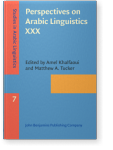Are there transfer effects in the Arabic comparative?
A contentious issue in Arabic linguistics concerns whether Arabic morphology is root-based or stem-/word-based. In a root-based approach, derivation depends on the consonantal root, which is understood as constituting a morpheme. This contrasts with the stem-/word-based view where derivation is based on a stem/word that includes a vowel. The strongest evidence for the stem-/word-based approach comes from morphological processes like the plural and diminutive. Based on this, Ratcliffe (1998) makes the strong claim that all Arabic morphology is word-based. In this paper I argue that the Arabic templatic comparative is a root-based process since unlike the plural and diminutive it witnesses no transfer effects from a supposed base. I conclude that Arabic allows both word-based and root-based derivation.
Article outline
- 1.Introduction
- 2.The Arabic broken plural and transfer effects
- 3.The Arabic comparative and the lack of transfer effects
- 3.1The comparative template
- 3.2Evidence against transfer effects in the Arabic comparative
- 3.3Possible marginal instances of transfer effects in the comparative
- 3.3.1The comparative of [gidiid] ‘new’/‘recent’
- 3.3.2Comparatives of forms with four root consonants in southern Levantine Arabic
- 4.Conclusion
-
Acknowledgements
-
References
References (29)
References
Badawi, E.-S., & Hinds, M. 1986. A dictionary of Egyptian Arabic. Beirut: Librairie Du Liban.
Benmamoun, E. 1999. Arabic morphology: The central role of the imperfective. Lingua 108, 175–201. 

Boudelaa, S., & Marslen-Wilson, W. 2001. Morphological units in the Arabic mental lexicon. Cognition 81, 65–92. 

Boudelaa, S., & Marslen-Wilson, W. 2005. Discontinuous morphology in time: Incremental masked priming in Arabic. Language and Cognitive Processes 20, 207–260. 

Broselow, E. 1976. The phonology of Egyptian Arabic (Doctoral dissertation). University of Massachusetts, Amherst.
Clements, G. N. 1985. The problem of transfer in nonlinear phonology. Cornell Working Papers in Linguistics 5, 38–73.
Davis, S. 2016. The Arabic comparative and the nature of templatic mapping in Arabic. In L. Körtvélyessy, P. Stekauer & S. Valera (Eds.), Word-Formation Across Languages (pp.73–90). Newcastle, UK: Cambridge Scholars Press.
Davis, S., & Ueda, I. 2006. Prosodic vs. morphological mora augmentation. Lexicon Forum 2, 121–143.
Hammond, M. 1988. Templatic transfer in Arabic broken plurals. Natural Language & Linguistic Theory 6, 247–170. 

Hassanein, A., & Kamel M. 1980. Yalla ndardish sawa. Cairo, Egypt: Arabic Language Unit, American University of Cairo.
Idrissi, A., Prunet, J.-F., & Béland, R. 2008. On the mental representation of Arabic roots. Linguistic Inquiry 39, 221–259. 

Lehn, W., & Abboud, P. 1965. Beginning Cairo Arabic. Austin: University of Texas Press.
McCarthy, J. 1979. Formal problems in Semitic phonology and morphology (Doctoral dissertation), Massachusetts Institute of Technology, Cambridge.
McCarthy, J. 1981. A prosodic theory of nonconcatenative morphology. Linguistic Inquiry 12, 373–348.
McCarthy, J. 1986. OCP effects: Gemination and antigemination. Linguistic Inquiry 17, 207–263.
McCarthy, J., & Prince, A. 1990. Foot and word in prosodic morphology: The Arabic broken plural. Natural Language & Linguistic Theory 8, 209–282. 

Prunet, J.-F., Beland, R., & Idrissi, A. 2000. The mental representation of Semitic words. Linguistic Inquiry 31, 609–648. 

Ratcliffe, R. 2013. Morphology. In J. Owens (Ed.), The Oxford handbook of Arabic linguistics (pp.71–91). Oxford: Oxford University Press.
Shimron, J. 2002. Semitic languages: Are they really root-based? In J. Shimron (Ed.), Language processing and acquisition in languages of Semitic, root-based morphology (pp.1–28). Amsterdam: John Benjamins.
Tewfik, L., & Harrell, R. 1957. Lessons in colloquial Egyptian Arabic. Washington D.C.: Georgetown University Institute of Language and Linguistics.
Watson, J. C. E. 2002. The phonology and morphology of Arabic. Oxford: Oxford University Press.
Watson, J. C. E. 2006. Arabic morphology: Diminutive verbs and diminutive nouns in San’ani Arabic. Morphology 16, 189–204. 

Youssef, I. 2013. Place assimilation in Arabic: Contrasts, features, and constraints (Doctoral dissertation). University of Tromsø, Tromsø, Norway.
Cited by (1)
Cited by one other publication
Faust, Noam & Nicola Lampitelli
2023.
Root and Pattern in Semitic – and Beyond. In
The Wiley Blackwell Companion to Morphology,
► pp. 1 ff.

This list is based on CrossRef data as of 29 july 2024. Please note that it may not be complete. Sources presented here have been supplied by the respective publishers.
Any errors therein should be reported to them.
